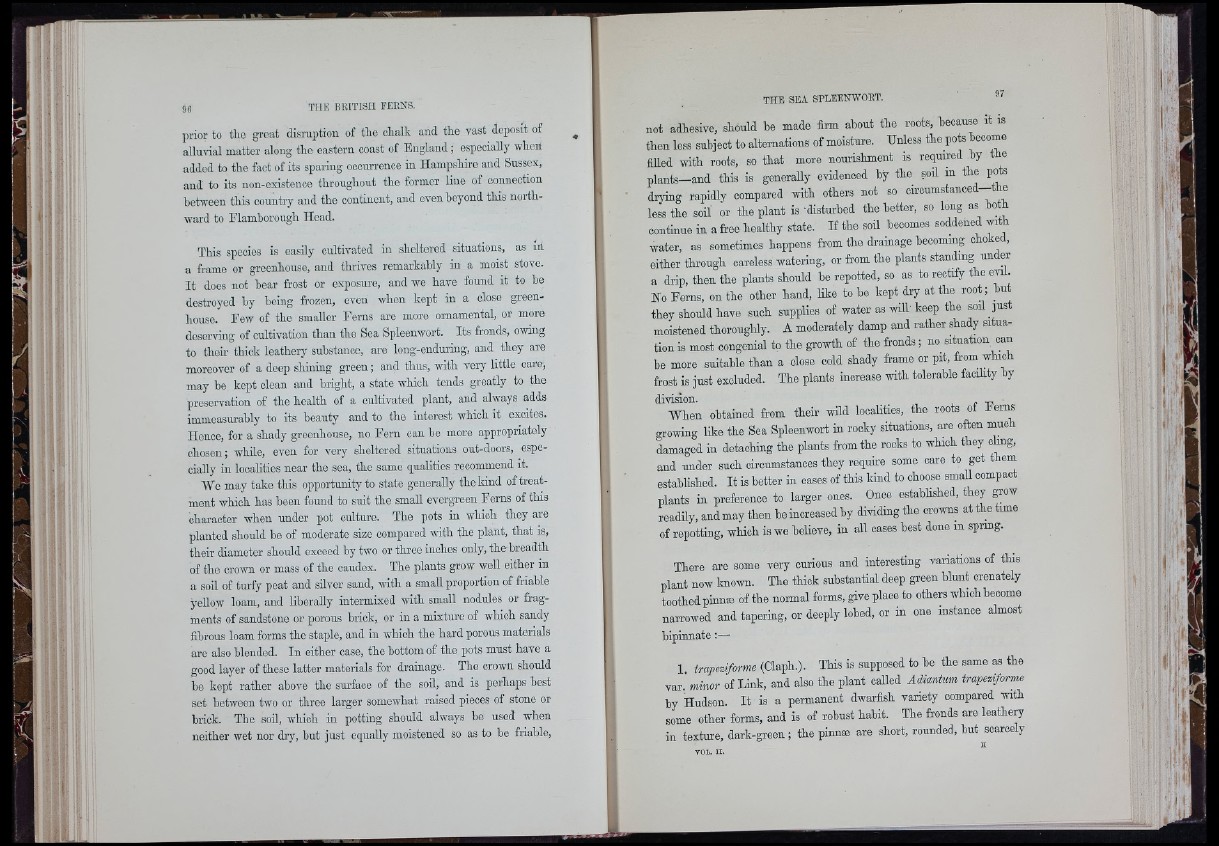
i '■
i tri
prior to the groat disruption of the chalk and the vast deposit of
alluvial matter along the eastern coast of England; especially when
added to the fact of its sparing ooourronce in Hampshire and Sussex,
and' to its non-existonoo throughout tho former line of connection
between this country and the continent, and even beyond this northward
to Elamborough Hoad.
This species is easily cultivated in sheltered situations, as iii
a frame or greenhouse, and thrives remarkably in a moist stove.
It does not bear frost or exposure, and we have found it to be
destroyed by being frozen, even when kept in a close greenhouse.
Few of the smaller Ferns are more ornamental, or moro
deserving of cultivation than the Sea Spleenwort. Its fronds, owing
to theii- thick leathery substance, are long-enduring, and they aro
moreover of a deep shining green ; and thus, with very little care,
may be kept clean and bright, a state which tends greatly to the
preservation of the health of a cultivated plant, and always adds
immeasurably to its boauty and to the interest which it excites.
Hence, for a shady greenhouse, no Fern can be more appropriately
chosen; while, even for very sheltered situations out-doors, especially
in localities near the sea, the same qualities recommend it.
We may take this opportunity to state generally the kind of treatment
which has been found to suit the smaU evergreen Ferns of this
character when under pot culture. The pots in which they are
planted should be of moderate size compared with the plant, that is,
their diameter should exceed by two or tbroe inches only, the-breadth
of the crown or mass of the caudex. The plants grow well either in
a soil of turfy peat and silver sand, with a small proportion of friable
jællow loam, and liberally intermixed with small nodules or fragments
of sandstone or porous brick, or in a mixture of wbioh sandy
fibrous loam forms the staple, and in which the hard porous materials
are also blended. In either case, the bottom of the pots must have a
good layer of these latter materials for drainage. The crown should
be kept rather above the surface of the soil, and is perhaps best
set between two or threo larger somewhat raised pieces of stone or
brick. The soil, which in potting should always be used when
neither wet nor dry, but just equally moistened so as to be friable.
not adhesive, should be made firm about the roots, because it is
then less subject to alternations of moisture. Hnless the pots become
filled with roots, so that more nourishment is required by e
plants—and this is generaUy evidenced by the soil in the pots
drying rapidly compared with others not so cironmstanoed-the
less the soil or the plant is 'disturbed tbe better, so long as both
continue in a free healthy state. If the soil becomes soddened with
water, as sometimes happens from the drainage beooming choked,
either through careless watering, or from the plants standing un er
a drip, then the plants should be repotted, so as to rectify the e^l.
No Ferns, on the other hand, like to be kept dry at the root; but
they should have such supplies of water as wifi.' keep the soil ]us
moistened thoroughly. A moderately damp and rather teady situation
is most congenial to the growth of the fronds; no situation can
be more suitable than a close cold shady frame or pit, from which
frost is just excluded. The plants increase with tolerable facility by
division.
When obtained from their wfid localities, the roots of Ferns
growing like the Sea Spleenwort in rooky situations, are often much
damaged in detaching the plants from the rooks to which they ohng,
and under such ciroumstances they require some care to get them
established. It is better in oases of this kind to choose small compact
plants in preference to larger ones. Once established, they grow
readily, and may then be increased by dividing the crowns at the time
of repotting, which is we believe, in all cases best done in spring.
There are some very curious and interesting variations of this
plant now known. The thick substantial deep green blunt crenately
toothed pinnæ of the normal forms, give place to others which become
narrowed and tapering, or deeply lobed, or in one instance almost
bipinnate :—•
1 trapeziforme (Claph.). This is supposed to be the same as the
yar. minor of Link, and also the plant caUed Adiantum trapeziforme
by Hudson. It is a permanent dwarfish variety compared with
some other forms, and is of robust habit. The fronds are leathery
in texture, dark-green ; the pinnæ are short, rounded, but scarcely
m
'Ii l.I
I
fi-': I
i t
11
I
■ d